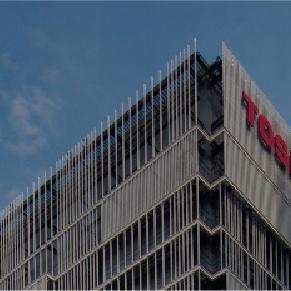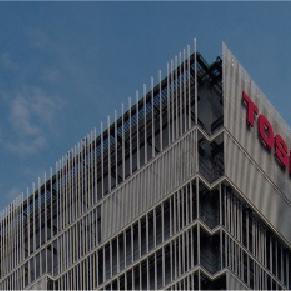Toshiba group Publishes "Toshiba Review Vol 74 No.1"
Green Energy Aggregation Cultivated for Effective Utilization of Renewable EnergyINFORMATION
Renewable Energy
Toshiba Energy Systems & Solutions Corporation
Toshiba group today published “Toshiba Review Vol 74 No.1”. Toshiba Review is a technical journal introducing Toshiba group's advanced technology development efforts and technical achievements.
This edition, features “Aggregation Business”, one of key businesses of Toshiba Energy Systems & Solutions Corporation (hereinafter Toshiba ESS). Toshiba group is developing the technologies which contribute to realize green energy aggregation, being one of them.
Toshiba is strengthening digital-related business that is oriented to resolving customer’s issues and that is performance based throughout the group. Digital solutions play an important role in increasing the usability of green energy.
Note 1
Virtual power plants contribute to optimization of the supply-demand balance in the power network by effectively controlling and operating multiple energy generation and storage facilities, such as solar power generation, storage batteries and hydrogen facilities scattered around a region, so as to make them function like a single power plant.
Outline
(URL: https://www.global.toshiba/ww/technology/corporate/review.html(Toshiba Corporation))
1. Toshiba’s Approaches to Green Energy Aggregation Service Contributing to Stabilization of Power Systems
Power generation systems utilizing renewable energy sources with no carbon dioxide emissions, also known as green energy systems, are expected to be widely introduced as a countermeasure against global warming. Such systems include solar photovoltaic (PV), wind power, and other systems. However, as these systems are affected by weather conditions, their output tends to be unstable. In this context, attention is being increasingly focused on green energy systems stabilized by the use of battery energy storage systems that can store surplus generated power. To increase the usability of green energy, new services utilizing information and communication technologies (ICTs) connecting the storage batteries of electricity users and various distributed energy resources, including demand response (DR), virtual power plants (VPPs), and the energy resource aggregation business (ERAB) employing DR and VPPs, have become widely disseminated. Various other technologies are also required in order to connect large amounts of electricity supplies utilizing renewable energy sources while maintaining the stable supply and demand of electric power systems.
The Toshiba Group is engaged in research and development aimed at facilitating the provision of a green energy aggregation service with high environmental value by integrating technologies for renewable energy power generation, VPP, and electric power systems.
2.Latest Technology for Solar PV Power Generation Systems
Toshiba Group is prompting the development of the latest technologies including efficient construction techniques using information and communication technologies (ICTs), an output fluctuation suppression technology for PV power generation systems equipped with a battery energy system, and a simulation technology to derive the optimal capacity of solar cell modules and a control technology to prevent surplus power generation for self-consumption type PV power generation systems.
3 .Latest Technologies for Wind Turbine Systems
Toshiba ESS has developed the following three technologies of PV power generation systems. (1) technique for precise evaluation and diagnosis of wind conditions, even in mountainous areas with complex terrain, employing both large-scale computational fluid dynamics (CFD)
analysis and wind source analysis software; (2) development of proprietary equipment to achieve a method for single-blade construction at small worksites; (3) enhancement of the performance of wind turbine generators and their compatibility with power systems based on rotating machine technologies cultivated through our thermal and hydroelectric power generation businesses.
4.Portfolio Management Technology to Select Optimal Combination of Electricity Users for Negawatt Aggregation Services
Negawatt aggregation services have been introduced in Japan since 2017 to balance electricity supply and demand by trading electricity shaved by electricity users in response to the requirements of electric power companies. Toshiba ESS has developed a portfolio management technology to select the optimal combination among a plurality of electricity users by precisely grasping the amount of negawatt power of individual users. It has evaluated the effect of its technology by using data that it has accumulated from past demand response (DR) events and confirmed that this technology achieves an increase in the amount of negawatt power.
5. Charge and Discharge Planning Technique for Multipurpose Utilization of Storage Batteries for Electricity Users
To realize effective utilization of the storage batteries of electricity users, Toshiba group has developed a storage battery charge and discharge planning technique for multipurpose use. This makes it possible to not only provide individual electricity users with services featuring a business continuity plan function in the event of an emergency as well as having and shifting functions based on demand forecasts, but also offers multiple services at the time of DR targeting all electricity uses.
6. Technologies for O&M services Supporting Introduction of Renewable Energy Generation Systems
Toshiba Group is promoting the development of technologies to realize remote monitoring systems using cloud services. It has developed a solution for PV power generation systems that can detect a decrease in power generation performance and automatically identify the cause, as well as a total solution aimed at improving the efficiency and availability of wind turbine systems.
7. Tandem Solar Cell Combining Transmission Type Cu2O Solar Cell with Si Solar Cell to Achieve High Efficiency and Low Cost
Toshiba has been developing a tandem solar cell composed of a transmission type Cu2O solar cell laminated on a dominant Crystalline Si solar cell with high efficiency and low cost as a key device for ultrahigh-efficiency solar PV generation that can achieve high electricity output even in a limited area. Toshiba has confirmed through simulations that this tandem solar cell achieves an ideal efficiency succeeding 30%. Applying our proprietary thin-film fabrication techniques, Toshiba has also succeeded for the first time in the world in forming an electricity-generating transmission type Cu2O solar cell on a transparent electrode, and have fabricated a prototype tandem solar cell using this Cu2O solar cell.
Information in the news release, including product prices and specifications, content of services and contact information, is current on the date of the news release , but is subject to change without prior notice.





